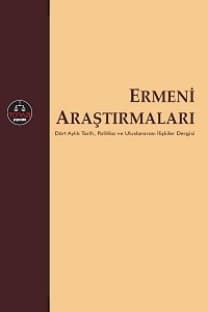AZERBAYCAN’DA SU KITLIĞI VE ERMENİSTAN İLE SARSANG REZERVUARI SORUNU
Azerbaycan, Ermenistan, Su, Dağlık Karabağ Sarsang Rezervuarı
(WATER SCARCITY IN AZERBAIJAN AND SARSANG RESERVOIR ISSUE WITH ARMENIA)
Azerbaijan Armenia, Water, Nagorno-Karabakh, SarsangResevoir,
___
- Alakbarov A.B., “Groundwater of Azerbaijan”, http://www.hydrology.nl/images/docs/ihp/groundwater_governance/Groun dwater_of_Azerbaijan.pdf
- “Azerbaijan, Georgia Make Progress Towards the Joint Sustainable Management of Kura River”, 1 May 2013. Online at: http://waterl.iisd.org/news/azerbaijan-georgia-make-progress-towards-the-joint-sustain able-management-of-kura-river/ Avazova M., “Water Resources of Azerbaijan, Their Management and Bilateral Agreements”, Almaty, September 10-13, 2012
- Batur Yamaner M., A. Emre Öktem , Bleda Kurtdarcan, Mehmet C. Uzun, 12 Ağustos 1949 tarihli Cenevre Sözleşmeleri ve Ek protokolleri, Galatasaray Hukuk Fakültesi Yayınları: 42, GSÜ ve ICRC, İstanbul.
- Bosnjakovic B., (1998), “UN/ECE Strategies for protecting the Environment with Respect to International Watercourses: The Helsinki and Espoo Conventions”, International Watercourses: Enhancing Cooperation and Managing Conflict. Washington.
- Campana Michael E., Berrin Basak Vener, and Baek Soo Lee, (2012), “Hydrostrategy, Hydropolitics, and Security in the Kura-Araks Basin of the South Caucasus,” Universities Council on Water ResourcesJournal of Contemporary Water Research & Education Issue 149, s. 22-32, December 2012.
- Er Tayfun, “Benden sonrası tufan”, Takvim Gazetesi, 14 Temmuz 2014, http://www.takvim.com.tr/guncel/2014/07/14/benden-sonrasi-tufan FAO,(2008), Irrigation in the Middle East region in figures; Aquastat Survey2008, FAO Water Reports 24, Roma.
- Gouldson A., Elena Lopez Gunn, Jamie Van Alstine, (2008), “New Alternative and Complementary Environmental Policy Instruments and the Implementation of the Water Framework Directive”, Europe Environment, 18.
- Imanov Farda A., (2007), “Water Infrastructure of Kura River Basin Within Azerbaijan”, International Congress on River basin management. http://www2.dsi.gov.tr/english/congress2007/chapter_1/08.pdf International Law Association (ILA), (2004), “Water Resources Law”, Berlin Conference, Fourth Report.
- “Islamic State militants threaten Turkey with violence if Euphrates water supply not restored”, 11 August 2015, online at: http://rt.com/news/179352- euphrates-is-militants-turkey/
- İmanov F.Ə., Ələkbərov A.B., ƏsədovM.Y., (2015) “Azərbaycanın su ehtiyatlarının müasir dəyişmələri və onların inteqrasiyalı idarə edilməsi”, Bakü.
- Kaika, M. , B.Page, (2003),“ The EU Water Framework Directive: Part 1. European Policy-Making and the Changinig Topography of Lobbying”, European Environment, 13, s.314-327.
- Mammadzadeh Ibrahim,“Water Resources Management in the Republic of Azerbaijan: Overview and Outlook”, http://www.gwp.org/Global/GWPCACENA_Files/en/pdf/azerbaijan.pdf
- Matthew McDonald, (2001), “The Environment and Security: The Euphrates River”, Department of Government University of Queensland. Mustafayev A, Rauf Garayev, “Legal Aspects of Reparation for Damage Caused to Azerbaijan as a Result of Armenian Aggression”, www.irsaz.com.
- Özyılmaz Emine Vildan, (2013), “Geçmişten Günümüze Dağlık Karabağ”, Gazi Üniversitesi İktisadi ve İdari Bilimler Fakültesi Dergisi 15 /2.
- Peter Gleick, (1993), “Water and Conflict; Fresh Water Resources and International Security”, International Security, vol.18, no.1.
- Reducing Transboundary Degradation in the Kura Ara(k)s River Basin, http://www.kura-aras.org/Welcome.html
- Rekolainen S., J.Kamari, M.Hiltunen, (2003), “A Conceptual Framework for Identifying the need ana Role of Models in the Implementation of the Water Framework Directive, Int. J. River Basin Management, vol.1, no.4.
- Rockström J., Malin Falkenmark, Louise Karlberg, Holger Hoff, Stefanie Rost andDieter Gerten, (2009), “Future water availability for global food production: The potential of green water for increasing resilience to global change”, Water Resources Research, Volume 45, Issue 7, July 2009
- Strategic Foresight Group, (2014), Water and Violence; Crisis of Survival in the Middle East, Mumbai.
- Swain, A., (2004), Managing Water Conflict; Asia, Africa And The Middle East, London, Routledge.
- Taslakyan L.,(2014), “Transboundary Management of the Kura-Araks River Basin”, Dundee.
- The State Statistical Committee of the Republic of Azerbaijan, http://www.stat.gov.az/source/agriculture/indexen.php “The Azerbaijan Republic National Water Strategy”, (2013)
- UN, (2004)“Environmental Performance Reviews of Azerbaijan”, Chapter 7: Water Management.
- UNESCO, (2006), Water as a Shared Responsibility, The United Nations World Water Development Report II, New York.
- World War II: Operation Chastise - The Dambuster Raids http://militaryhistory.about.com/od/aerialcampaigns/p/dambusters.htm
- Vener Berrin Basak, (2006), “The Kura-Araks Basin: Obstacles and Common Objectives for an Integrated Water Resources Management Model among Armenia, Azerbaijan, and Georgia”, Unpublished Master thesis.
- Verdiyev R., (2012) “National Water Strategy of Azerbaijan Republic”, Cenevre.
- Yılmaz R., (2010), “Azerbaycan Dış Siyasetinde Bağımsızlık Sonrası Yıllar ve Karabağ Problemi”, Sosyal Bilimler Araştırmaları Dergisi.
- ISSN: 1303-068X
- Yayın Aralığı: Yılda 2 Sayı
- Başlangıç: 2001
- Yayıncı: Avrasya İncelemeleri Merkezi
ERMENİ SEVK VE İSKÂNININ (TEHCİRİN) ALTINDA YATAN NEDENLER
AZERBAYCAN’DA SU KITLIĞI VE ERMENİSTAN İLE SARSANG REZERVUARI SORUNU
“Türkler ve Ermeniler: Milliyetçilik ve Osmanlı İmparatorluğunda Çatışma”
“Türkler ve Ermeniler: Milliyetçilik ve Osmanlı İmparatorluğunda Çatışma”
İSTANBUL’DA BİR İNGİLİZ KONSOLOS VEKİLİ: FİTSMORİS VE ERMENİ MESELESİNE DAİR RAPORU
ERMENİ ASILLI OSMANLI NAZIRLARINDAN GABRİYEL NORADUNKYAN EFENDİ
TARİH, TRAVMA VE KİMLİK: ERMENİ DİASPORADA KİMLİK VE KİMLİĞİN YENİ NESİLLERE AKTARIMI
